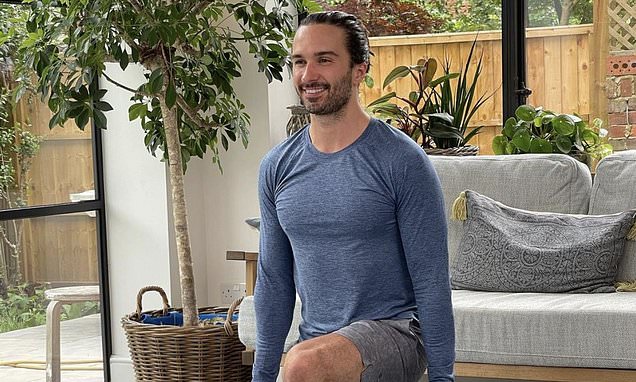Why Joe Wicks’ HIIT really IS the secret to staying slim: Brutal bursts of squats, burpees and push-ups burn more fat than just running, study claims
- HIIT workout fanatics burn up to 0.13g of fat more per minute of activity they do
- This could see them lose an extra 10kg over a decade, according to researchers
- The workouts involve burpees, squats and push ups interspersed with rest
Following Joe Wicks’ brutal exercise regime really is the best way to lose weight, a study suggests.
The nation’s favourite work-out guru, nicknamed the Body Coach, is an advocate of trendy high-intensity interval training (HIIT).
It burns a sweat by making people do burpees, squats and push-ups interspersed with intervals of rest.
But experts have now confirmed that it’s more effective at keeping your waistline in check than traditional aerobic exercise, like running or swimming.
Researchers claim just three 30-minute sessions a week can turn your body into a ‘fat-burning machine’ — and say it may work even better in fat people.

Those who do high-intensity interval training per week burn up to 0.13g of fat more for every minute of physical activity they do, compared to those who do no exercise, according to a team of international researchers. The workouts, which involve burpees, squats and push ups interspersed with rest, were made popular by Joe Wicks (pictured), who uploads videos online as the Body Coach
Adults are encouraged to do some type of physical activity every day. Exercise just once or twice a week can reduce the risk of heart disease or stroke.
Over-18s should aim to:
- Do strengthening activities that work all the major muscle groups (legs, hips, back, abdomen, chest, shoulders and arms) on at least two days a week. This includes carrying heavy shopping bags, yoga, pilates and lifting weights.
- Do at least 150 minutes of moderate intensity activity a week or 75 minutes of vigorous intensity activity a week. Moderate activity includes brisk walking, riding a bike, dancing and doubles tennis. Vigorous activity includes running, swimming and riding a bike fast or on hills.
- Spread exercise evenly over four to five days a week, or every day
- Reduce time spent sitting or lying down and break up long periods of not moving with some activity
Adults can also achieve weekly activity target with:
- Several short sessions of very vigorous intensity activity. This includes lifting heavy weights, circuit training and sprinting up hills.
- A mix of moderate, vigorous and very vigorous intensity activity
Source; NHS
They are still encouraging people to stick to other conventional forms of burning a sweat.
Although, the team at Melbourne’s Victoria University are encouraging people to become HIIT fanatics.
Their calculations suggest adding three quick-fire sessions in every week might help burn an extra 0.13g of fat per minute of exercise.
Over the course of a decade, those who do the recommended two-and-a-half hours of aerobic exercise may theoretically lose an extra 10kg (22lbs).
Study author Professor Zeljko Pedisic said: ‘If you are not already doing it, maybe you should give it a go.’
Numerous studies have shown HIIT boosts fat oxidation — the process of breaking down fat stored in the body.
Until now, however, researchers had not compared fat oxidation rates among those who do HIIT workouts with other forms of exercise.
To investigate this, researchers pooled results from 18 studies, each of which looked at how much fat was burned during workouts.
Some 511 participants engaged in supervised workouts — HIIT or moderate-intensity activities such as running and cycling — or did no exercise.
They were monitored for three sessions per week for two to 14 weeks.
The findings, published in the British Journal of Sports Medicine, show that just four weeks of HIIT workouts improve fat burning by an extra 0.08g per minute compared to those who do no exercise.
People who prefer conventional aerobic workouts, like jogging, will also experience an improvement in their fat metabolism.
But the benefit was lower than those who engaged HIIT (0.03g per minute), results showed.
This means aerobic exercise fans would need to workout for longer to see the same effects, the team said.
The researchers admitted their findings weren’t fool-proof as it included studies that used different training methods and in different populations.
And they only monitored the effects for three months.
Source: Read Full Article
